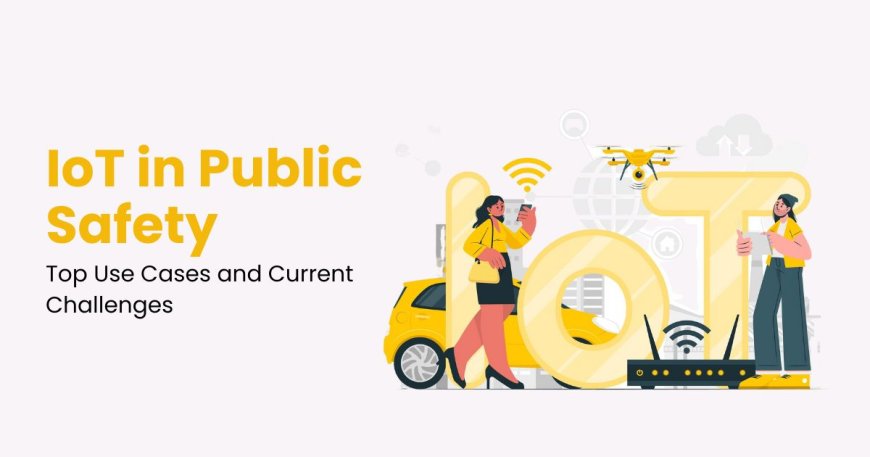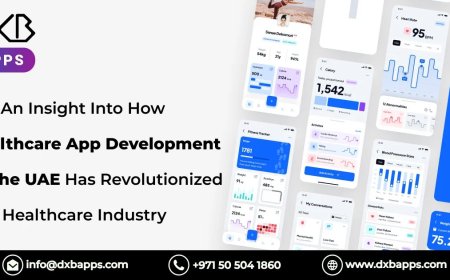IoT in Public Safety: Top Use Cases and Current Challenges
Discover how IoT enhances public safety with top use cases and challenges in technology implementation for a safer, smarter environment.

The Internet of Things (IoT) has evolved from a convenience-based technology to a critical element in modern safety systems. In the field of public safety, IoT plays a transformative role by offering real-time data, advanced automation, and actionable insights, which help authorities manage emergencies effectively. From monitoring infrastructure to enabling quick emergency responses, IoT has enhanced public safety in diverse ways. This article examines the top use cases of IoT in public safety and the current challenges associated with its deployment, offering a technical and insightful view of its potential.
1. The Growing Importance of IoT in Public Safety
In the face of growing urbanization, increasing population density, and climate change, public safety organizations require reliable technology to predict, respond to, and mitigate crises. IoT technology empowers these organizations with data-driven insights, enabling faster and more effective responses. By using IoT devices, cities can monitor weather patterns, detect environmental changes, and even foresee incidents before they escalate, making IoT development services and IoT consulting services invaluable for building a safer environment.
-
Fact: As of 2023, over 7 billion IoT devices were in use globally, with a significant portion dedicated to public safety applications.
-
Stat: According to the IDC, IoT spending in public safety is expected to reach $100 billion by 2025.
2. Top Use Cases of IoT in Public Safety
The applications of IoT in public safety span across sectors such as emergency response, disaster management, environmental monitoring, and law enforcement. Here are some of the top use cases where IoT is enhancing public safety.
Smart Emergency Response Systems
IoT enables emergency response systems to be more agile, efficient, and precise. By integrating IoT devices with emergency response networks, authorities can receive real-time data on incidents, enabling them to deploy resources more effectively.
-
Example: Sensors in urban areas can detect gunshots, alerting law enforcement with precise location data, and allowing for a faster response.
-
Functionality: IoT devices provide emergency responders with live information, reducing response times and helping save lives.
Disaster Prediction and Management
With IoT sensors placed in vulnerable regions, authorities can monitor environmental changes like temperature, humidity, and air pressure to predict natural disasters. This data helps prepare resources, issue timely warnings, and ultimately, reduce casualties.
-
Case in Point: Japan uses IoT sensors to monitor seismic activity. Data from these sensors helps anticipate earthquakes and provide early warnings.
-
Technical Aspect: Predictive analytics algorithms process data from IoT sensors, identifying patterns that suggest an impending natural disaster.
Air Quality and Pollution Monitoring
Air quality monitoring is crucial in urban areas where pollution levels can impact public health. IoT-based air quality sensors provide real-time data on pollutants, allowing city authorities to take immediate action.
-
Stat: According to WHO, air pollution causes 4.2 million premature deaths annually.
-
Example: In New York City, IoT air quality sensors installed throughout the city track pollutants and notify authorities when levels exceed safe limits.
Infrastructure Monitoring for Safety
IoT technology assists in monitoring critical infrastructure, such as bridges, dams, and public buildings. Sensors can detect structural weaknesses, leaks, or unusual vibrations that might signal a risk, thus preventing accidents.
-
Technical Insight: IoT sensors measure pressure, load, and structural integrity in real-time. They immediately notify maintenance teams when thresholds are crossed, allowing for preventive action.
-
Example: The Golden Gate Bridge uses IoT sensors to monitor structural health, ensuring timely maintenance and public safety.
Surveillance and Security Systems
In public areas, IoT-enhanced surveillance systems provide enhanced security. These systems integrate cameras, sensors, and data analytics to detect suspicious activities and alert law enforcement.
-
Example: In many smart cities, surveillance systems leverage facial recognition and AI to track missing persons or identify potential threats.
-
Argument: While these systems increase security, they raise privacy concerns, making it crucial to balance public safety and individual rights.
Traffic and Road Safety Management
IoT applications in road safety include traffic monitoring, accident detection, and smart traffic lights. IoT sensors detect and report road incidents, providing critical information for improving traffic flow and reducing accidents.
-
Case Study: Singapore's smart traffic management system uses IoT sensors to control traffic lights dynamically, reducing congestion and lowering accident risks.
-
Stat: According to the World Health Organization, road accidents cost countries around 3% of their GDP, making IoT-based traffic solutions a valuable investment.
Also Read: IoT-Enabled Smart Lighting Systems: The Future of Energy-Efficient Cities
3. Current Challenges in IoT-Enabled Public Safety
Despite its advantages, IoT deployment in public safety faces significant challenges. These range from technical limitations to privacy issues, which must be addressed to optimize IoT's role in safeguarding the public.
Data Security and Privacy Concerns
One of the major concerns with IoT in public safety is data privacy. IoT devices collect vast amounts of personal data, raising concerns about data misuse and unauthorized access.
-
Argument: Privacy regulations, such as GDPR, require stringent measures to protect personal data. IoT development services must prioritize secure data handling and compliance.
-
Example: A network of IoT cameras in public spaces could collect identifiable information, necessitating data protection measures to avoid misuse.
Scalability and Infrastructure Compatibility
IoT deployment for public safety requires substantial infrastructure. Legacy systems cannot often integrate with new IoT technologies, leading to compatibility issues and requiring infrastructure upgrades.
-
Technical Challenge: IoT systems generate high volumes of data, requiring robust infrastructure for storage, processing, and analysis.
-
Argument: IoT consulting services can assist in assessing the infrastructure needs and designing systems compatible with existing public safety technology.
High Implementation Costs
IoT projects, especially in public safety, demand significant investment in devices, connectivity, and maintenance. High initial costs can limit IoT adoption, especially in budget-restricted public safety departments.
-
Stat: IoT deployment in smart cities is estimated to cost between $30 to $50 billion by 2025.
-
Solution: IoT development services can help optimize costs by offering tailored solutions that meet the specific needs of public safety agencies.
Cybersecurity Threats
IoT devices are often vulnerable to cyberattacks, which can compromise public safety data. Ensuring IoT system security is critical, as compromised data could hinder emergency responses and lead to severe consequences.
-
Example: In 2021, a cyberattack on a water treatment facility in Florida demonstrated how vulnerable IoT-connected infrastructure can be.
-
Solution: Robust cybersecurity protocols and frequent system updates are necessary to safeguard IoT infrastructure against cyber threats.
Data Overload and Processing Challenges
With the large amounts of data generated by IoT devices, processing this information can be challenging. Authorities need efficient data analysis tools to extract actionable insights from the data.
-
Argument: Without efficient data processing, IoT-generated data becomes overwhelming and fails to provide timely information.
-
Solution: Advanced analytics platforms and AI integration with IoT systems help manage large data volumes, enabling quicker responses.
4. The Future of IoT in Public Safety
The future of IoT in public safety is promising, with advancements in AI, machine learning, and edge computing expected to enhance its capabilities. As IoT technology improves, it will offer more precise data, faster processing, and stronger cybersecurity measures.
-
Emerging Trends: Edge computing will reduce latency, allowing for real-time data analysis at the source. AI and machine learning will help predict incidents with higher accuracy.
-
Long-Term Potential: IoT will play a pivotal role in creating smart, resilient cities capable of addressing emergencies and ensuring the safety of their residents.
Conclusion
IoT technology transforms public safety by enabling real-time monitoring, efficient emergency responses, and proactive disaster management. IoT supports public safety efforts in many critical areas through various applications like smart emergency systems, disaster prediction, and infrastructure monitoring. However, challenges like data privacy, cybersecurity, and implementation costs hinder widespread IoT adoption.
As IoT development services and IoT consulting services continue to innovate and provide tailored solutions, IoT's role in public safety will likely expand, making it a vital part of safe and resilient communities. Embracing IoT technology requires thoughtful planning, commitment to data privacy, and a robust infrastructure, but its benefits for public safety make it a valuable investment in the future.
What's Your Reaction?

























